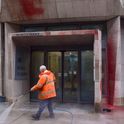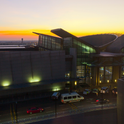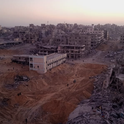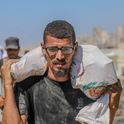As the world focuses its attention on Israel’s war with Iran, our situation in Gaza worsens. Here, safe food aid has vanished, markets have collapsed and only two means remain for getting food: either the new US- and Israel-backed food donation centres, where one risks death from Israeli soldiers, or black markets.
In Gaza’s markets—once bustling with fresh produce—shelves now stand nearly empty. I watch shoppers move silently past the few remaining stalls, prices far beyond reach. Since the most recent escalation and tightened blockade, the economy has collapsed, and food prices have surged by up to 1,400 per cent.
In the past year, the price of a bag of flour has jumped from 50–60 shekels to as much as 1,800 shekels, or around £370 (part of living under occupation is being dependent on the Israeli shekel). Meat has been absent since March. Vegetables, when found, sell by the piece.
The collapse of transport systems and lack of regulation has enabled a few vendors to dominate markets, where desperation fuels a black economy for the small minority of people with cash.
These black markets have flourished unchecked. In northern Gaza, makeshift vendors have established markets along battered streets and inside dilapidated buildings, charging exorbitant commissions simply for cash withdrawals.
Basic staples have become unaffordable luxuries: a kilo of coffee now sells for 800 shekels, adulterated with lentils and chickpeas. Coffee has become a marker of resilience, a symbol of normality in abnormal conditions, which is then exploited by sellers on the black market.
“With safe aid halted and profiteers taking control, we must choose between starvation and debt,” one displaced father told me in a crowded black market in northern Gaza. “Sometimes, there is nothing left to choose.”
For most people, however, the black market is unaffordable. On Al‑Eidiyah Street in Gaza City, displaced residents queue quietly outside a closed UN World Food Programme (WFP) soup kitchen. Among them stands Asmahan Saadeh, 43, cradling an empty pot, in the hope that the soup kitchen will open again.
“I’m pregnant,” she says softly. “This is the fourth day I’ve come here and returned with nothing. The situation is unbearable.”
Children wait nearby, sitting on the pavement; elderly men and women lean against low walls, clutching empty containers in hope of a single meal.
“For us, this soup kitchen is the only way to survive,” Saadeh explains.
Nearly 90 percent of Gazans have been displaced at least once. UN-supported bakeries have closed, and community kitchens struggle to operate.
Families now ration scraps. Crushed macaroni mixed with scant flour forms a single piece of bread per person per day. Food staples like flour require water and heat to turn into food, but access to clean water has disappeared. Nine out of 10 Gazans don’t have access to safe drinking water.
Overcrowded shelters have become breeding grounds for disease, and child malnutrition is rising.
Now sheltering with her four children in her parents’ home, Saadeh faces hunger daily. “There are six of us—not a grain of flour left,” she tells me. “I’ve forgotten the taste of sugar. This morning, my 10-year-old son cried for tea. We had none.”
Before the war, Saadeh worked in a nursery; her husband’s factory job vanished when the building was destroyed in an airstrike. Two of their children suffer from chronic eye conditions, and another needs liver surgery they cannot afford.
“When we fled south, we lived for 18 months in a chicken coop,” she says. “Now, I divide one pita into four—one piece for each child. We survive on one meal a day. Vegetables are a dream for my children.”
More than enough food stands waiting at the Gaza border. In its most recent statement, the WFP said that it had transported more than 700 trucks of aid to the Kerem Shalom border crossing point as of 10th June, but around 45 per cent of the food had not been able to enter.
It said that the food that had entered Gaza was only “enough to support less than 300,000 people for a month with minimal daily food requirements… This is a small fraction of what is needed for a population of 2.1m people and far too slow to meet the overwhelming needs.”
In a tent near Al‑Jalaa, Abu Ibrahim Al‑Ladaa, 32, crouches beside a small fire, baking scraps of dough for his family. In the absence of fuel, people have been improvising with homemade fire pits to heat water and cook, but even firewood is becoming scarce.
“I’m not a baker,” he tells me quietly, “But I must do what I can so we can survive.”
Before the war, Al-Ladaa owned a poultry farm in Shejaiya. Two weeks ago, a shell struck their street. “The front of our house was gone,” he says. “My brother stayed behind. It was the worst night of his life.”
Al-Ladaa fled with his wife and children to a school formerly run by UNRWA, the UN agency that supports Palestinian refugees. It is now an overcrowded tent camp.
The day after we left, airstrikes flattened the street. Nothing was left. When I tried to go back for flour, a drone fired at me.
Now homeless and jobless, he clings to hope. “All I have left is the will to survive, and a hope to return.”
For Gaza’s displaced families, hunger is no longer temporary—it defines daily life. In a tented camp, Al-Ladaa stokes his fire, uncertain what tomorrow will bring. On Al-Eidiyah Street, Saadeh waits, pot in hand, praying for a meal.
“We escaped death,” Al-Ladaa says. “But now, we are losing everything.”













